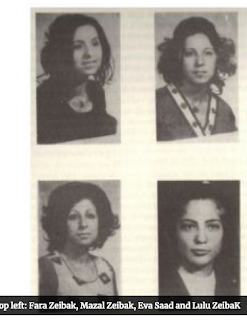
This time of year is the 45th anniversary of the murder of four Syrian-Jewish girls as they tried to reach Israel. Their plight, here described by Chrstopher Robbins in Israel Hayom, is emblematic of the years of horror endured by the 3,000 Jews trapped as hostages in the country until they were released in the 1990s. There is still a handful of Jews living in Syria. (With thanks: Lily)
The four girls from the Zeibak and Saad families were raped and murdered
Those who stayed in Syria started to realize that the smaller the Jewish community became, the greater the chance that gratuitous or preplanned mob – even government – violence would visit upon its remaining individuals. At some point, the risk of violence is so high that it forces a decision. Is it better to ride out the Syrian storm or to put your family at risk on the open road in an attempt to escape?
Should we stay or should we go? These two questions are usually posed in unison. Our people have asked these questions in nearly every language we have ever spoken. The answers are often given in whispers, in dark rooms, in attics, or basements, and between anguished tears.
In 1974, the Mossad and various Jewish charities were working overtime to clandestinely smuggle Jews out of Syria. Relationships, networks and smuggling routes were established. Israeli and diaspora money was effectively deployed. Judy Feld Carr, a Canadian Jew, and her supporters, helped smuggle over 3,000 Jews out of the country. The Mossad was running constant operations as well, many in cooperation with the Israeli Defense Force.
Regrettably, the Syrians caught on quickly. They increased the number of men and arms at the border. The feared Mukhabarat was put on high alert. A Jewish boy was shot in the leg by a Syrian soldier while crossing the border with a Mossad handler. Two other boys, Natan Shaya and Kassem Abadi, seemingly vanished on their attempt at freedom.
Back at their homes in the Jewish Quarter, the Zeibak and Saad families’ discussions had concluded. Now the conversation shifted to strategies and plans. Slip away at night? Or try and fade away on a trip to the market? How long before the Mukhabarat or a nosy neighbor notices our absence? What can they take with them? Family photos, heirlooms, keepsakes? Or just a small bag with cash and other items that can be easily converted to cash?
It was the fear of premature discovery, as well as their daughters’ zeal to start anew in Israel as soon as possible, that led them to send the young women first. Lulu, Mazal, Fara and Eva would rendezvous with a group of smugglers. The smugglers had been recommended by two of their friends in the Jewish community. It was all arranged. Perhaps the cold and rainy weather would be a benefit, keeping border patrols to a minimum as temperatures dropped into the 20s.
We can imagine the scene as the women departed. For thousands of years, our people have often had to say goodbye in circumstances which make reunions uncertain. The family’s handoff of their daughters to Syrian smugglers was an agonizing moment for the women’s parents.
The trip into the mountains may have started well. As they left the confinement of the Jewish Quarter they would have passed valleys, brooks, waterfalls, caves and Roman ruins that dot the region. It may even have been possible for the women to begin to anticipate long-awaited freedom as they neared the Lebanese border. Lulu, Fara, Mazal and Eva doubtless imagined what life in Israel would be like for them. We will never know.
The women’s bodies were found on March 2, 1974. They were discovered in a cave outside Al-Zabadani. They had been raped before they were murdered. Their bodies were hacked to pieces and burned by acid almost beyond recognition. They had also been robbed. A finger of one of the young women had been cut off in order to remove a ring.
Syrian police returned the women’s remains to their families in burlap sacks. They cavalierly deposited the sacks in front of their parents’ homes on Purim.
The bodies of Natan Shaya and Kassem Abadi were also discovered in the cave. They were likely victims of an earlier massacre. The boys were also attempting to reach freedom in Israel. While the official statement of the Syrian government is that smugglers were responsible, some people believe the atrocity was committed by Syrian soldiers.
A member of the Zeibak family said that to this day the Syrian government has concealed all facts from them.

Leave a Reply